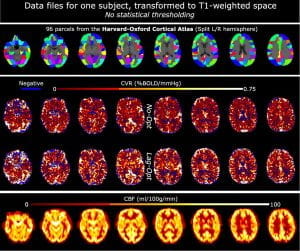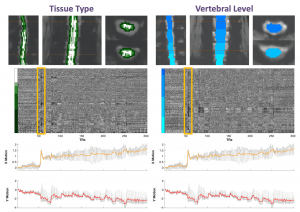
We are thrilled to announce that Dr. Neha Reddy has successfully defended her doctoral dissertation, entitled Systems-level sensorimotor mapping with fMRI for applications in brain disorders! Neha’s research has significantly advanced sensorimotor mapping through innovative fMRI and signal-processing methodologies. Her work with multi-echo independent component analysis and whole-brain fMRI has improved understanding of somatosensory and motor neural systems and will advance knowledge of how these systems are impacted in neurological impairment such as stroke.
Throughout her time in the Bright Lab, Neha has demonstrated exceptional research skills, technical innovation, and leadership. Her work ethic and intellectual curiosity have been instrumental to our lab’s success, and have set a high standard that we will endeavor to live up to. We wish her best of luck as she returns to medical school this summer, and look forward to witnessing her continued contributions to the field of medicine as a physician-scientist! Please join us in congratulating Dr. Reddy on this remarkable achievement!
 Many congratulations to Kristina Zvolanek, who successfully defended her PhD in Biomedical Engineering on January 9! Her thesis, entitled Novel functional MRI approaches for mapping cerebrovascular hemodynamics in sickle cell disease, addresses critical gaps in understanding cerebrovascular complications in pediatric sickle cell disease. Her work has developed innovative functional MRI approaches to measure cerebrovascular reactivity and circulation time, creating new pathways for investigating hemodynamics in this vulnerable population.
Many congratulations to Kristina Zvolanek, who successfully defended her PhD in Biomedical Engineering on January 9! Her thesis, entitled Novel functional MRI approaches for mapping cerebrovascular hemodynamics in sickle cell disease, addresses critical gaps in understanding cerebrovascular complications in pediatric sickle cell disease. Her work has developed innovative functional MRI approaches to measure cerebrovascular reactivity and circulation time, creating new pathways for investigating hemodynamics in this vulnerable population. Hand-grasping is an important and clinically significant daily function, but more work is needed to understand the associated spinal cord neural activity. In this study, participants performed a hand-grasping task with both hands and spinal cord fMRI motor activation was modeled with two methods: (1) a typical idealized block design (Ideal) and (2) based on recorded grasp force normalized to individual maximum voluntary contraction (%MVC). Robust detection of hand-grasping activity was shown in the spinal cord, highly lateralized ipsilateral to the side of the task. In addition, the impact of sample size, number of fMRI runs, and spatial smoothing on activation estimates was explored. Overall, we emphasize the importance of a task that is well-controlled within and across participants. Using individually calibrated tasks in people with motor impairments will be especially beneficial to compare across groups.If you want to learn more, please check out the
Hand-grasping is an important and clinically significant daily function, but more work is needed to understand the associated spinal cord neural activity. In this study, participants performed a hand-grasping task with both hands and spinal cord fMRI motor activation was modeled with two methods: (1) a typical idealized block design (Ideal) and (2) based on recorded grasp force normalized to individual maximum voluntary contraction (%MVC). Robust detection of hand-grasping activity was shown in the spinal cord, highly lateralized ipsilateral to the side of the task. In addition, the impact of sample size, number of fMRI runs, and spatial smoothing on activation estimates was explored. Overall, we emphasize the importance of a task that is well-controlled within and across participants. Using individually calibrated tasks in people with motor impairments will be especially beneficial to compare across groups.If you want to learn more, please check out the 
 How reliable are our current techniques for processing spinal cord fMRI data? In a recently published paper, Dr. Mark Hoggarth and Max Wang explore how person-to-person variability in the contouring of fMRI spinal cord masks affects downstream analyses. Using masks drawn by 8 raters of varying experience to inform co-registration to standard template space, they identify spatial differences in the accuracy of registration related to underlying image contrast and rater experience. At the group-level, spatial differences were present in activation maps although no systematic effect on overall activation level was identified. This work characterizes how variability in manually contoured masks propagates to results in spinal cord fMRI, demonstrating that standardization of processing pipelines and improving image acquisition should be prioritized.
How reliable are our current techniques for processing spinal cord fMRI data? In a recently published paper, Dr. Mark Hoggarth and Max Wang explore how person-to-person variability in the contouring of fMRI spinal cord masks affects downstream analyses. Using masks drawn by 8 raters of varying experience to inform co-registration to standard template space, they identify spatial differences in the accuracy of registration related to underlying image contrast and rater experience. At the group-level, spatial differences were present in activation maps although no systematic effect on overall activation level was identified. This work characterizes how variability in manually contoured masks propagates to results in spinal cord fMRI, demonstrating that standardization of processing pipelines and improving image acquisition should be prioritized.

 Check out our conference paper that was presented at the IEEE Engineering in Medicine and Biology Conference and published online in December 2021! This paper details our method, developed by PhD candidate Kimberly Hemmerling, for visualization of complex spinal cord fMRI data as heatmaps. This work was inspired by a visualization technique designed for brain fMRI data (Power et al., 2017). Our heatmaps can be visualized alongside motion or physiological traces that may be used to identify coincidence of signal variation. The technique may be easily integrated into a preprocessing pipeline to visualize the effect of a preprocessing step, identify spatially or temporally varying artifacts, or to assess general data quality.Check out the work
Check out our conference paper that was presented at the IEEE Engineering in Medicine and Biology Conference and published online in December 2021! This paper details our method, developed by PhD candidate Kimberly Hemmerling, for visualization of complex spinal cord fMRI data as heatmaps. This work was inspired by a visualization technique designed for brain fMRI data (Power et al., 2017). Our heatmaps can be visualized alongside motion or physiological traces that may be used to identify coincidence of signal variation. The technique may be easily integrated into a preprocessing pipeline to visualize the effect of a preprocessing step, identify spatially or temporally varying artifacts, or to assess general data quality.Check out the work 
 Congratulations to postdoctoral research fellow Rachael Stickland and colleagues on our publication in Neuroimage, titled
Congratulations to postdoctoral research fellow Rachael Stickland and colleagues on our publication in Neuroimage, titled